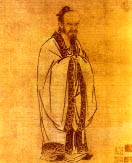| Laozi and His Magnum Opus the Daodejing
By WEN HAIMING
LAOZI, a contemporary of Confucius (551-479 BC), is considered to be one of the most significant philosophers to emerge in ancient China. He founded Daoism and is best known as the author of the Daodejing.
According to historical records, Laozi’s name was Li Er. As head of the national library of the Zhou Dynasty (1046-256 BC) he had broad access to the philosophical, historical and literary works of the time and became a famous scholar. However, as he noted the corruption in political circles and the decline of the kingdom, he retreated into life as a hermit. Legend has it that at the western border of Zhou, he was recognized by chief of the border garrison. The officer asked him to put his wisdom in writing, and this is believed to be the origin of the sparse text of the Daodejing, which consists of only about 5,000 characters.
Laozi explores the concept of Dao throughout the Daodejing. The literal meaning of Dao is both a path (or way) and that which is spoken of, departing in every sense from the simple notions like a “channel of communication.” It can be comprehended in Western terms through the ancient word logos, the principle governing the cosmos, the source of this principle, and human reasoning about the cosmos. This kind of “way” is clearly difficult to define in language. Nowadays we cannot discuss Daoist philosophy and religion without talking about Laozi’s idea of Dao, this Chinese character that has since been accepted into many other languages. Even for Laozi himself, Dao was a carefully chosen word, all others coming up short to express the many levels of mystical sensibility to which he referred. It is unlikely he expected it to come into such wide usage when people centuries later studied Chinese philosophy. And it is ironic that even Laozi himself felt that it was impossible to clearly define the Dao. Many different levels of significance have been opened up by his teachings. Much of the meaning may be lost in translation, like chewed food has lost its taste and flavor. Let’s just hope we’ve not talked (Dao) too much and traveled (Dao) too far from its original way (Dao)!
The profundity of the Daodejing guides people not only to examine their relationship with the world, but also to see and relate to the world through this relationship. Laozi promotes the sensibility of being integrated with nature without any linguistic system or existing method of expression as a mediator. Laozi puts forward that whatever can be named or defined is not the Dao. Dao is changing and moving, but is relatively constant.
 |
|
An ancient portrait of Laozi. |
The Dao of Heaven-and-Earth
Laozi wrote these famous lines in his opening passage, which might still remain the obscurest of the obscure: “Way-making (Dao) that can be put into words is not really way-making.” It seems whatever he wrote is not dependable either, and whatever is dependable is not constant way-making. Thus, one typical characteristic of the Dao is “obscurity.” The real Dao is beyond description since once it is put into words, it is no longer fundamental, basic and lasting. Like the beginning of the cosmos, Dao always creates, but we cannot depict it clearly, so we can only provide the name Dao for it. Dao is a state that people can feel but cannot speak of.
Laozi used two concepts: being (you) and non-being (wu) to support the idea that Dao is beyond words. Existentially, “non-being” is a state of emptiness, the nothingness prior to the cosmos. Thus it is phrased as wu (non-being). It is often called “the fetal beginning of the myriad things” to admit that things must have begun at a state of being named (youming). Just like the question whether the hen or the egg came first, the question of whether being or non-being came first has been difficult to answer throughout the history of philosophy. The state of the original happening of heaven and earth is beyond words, so we can only use “being” and “non-being” to describe it.
The explanation of the origin of the cosmos requires very subtle and delicate navigation of meaning. Laozi mentioned a series of wu forms, and tempted people to experience the state of nothingness. One can feel the yin-yang communion and its continuity: the actual boundary or distinction between being and non-being still operates within the view that heaven and earth are inseparable. Everything is a taiji, with one aspect that can be taken to be yang, and another aspect that can be taken as yin, and in totality to be taken as yin-yang continuity. Everything has duality, and one can expand one’s limited experience of this double nature to the entire world. This is the ontological sensibility of being and non-being.
|
